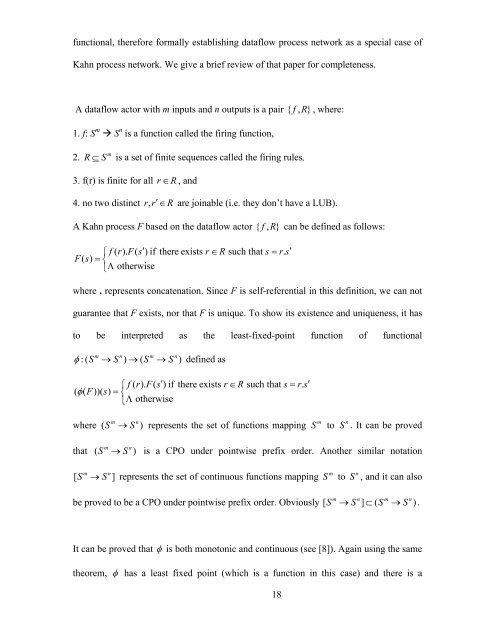Dynamic Dataflow Modeling in Ptolemy II - Ptolemy Project ...
Dynamic Dataflow Modeling in Ptolemy II - Ptolemy Project ...
Dynamic Dataflow Modeling in Ptolemy II - Ptolemy Project ...
Create successful ePaper yourself
Turn your PDF publications into a flip-book with our unique Google optimized e-Paper software.
functional, therefore formally establish<strong>in</strong>g dataflow process network as a special case of<br />
Kahn process network. We give a brief review of that paper for completeness.<br />
A dataflow actor with m <strong>in</strong>puts and n outputs is a pair { f , R } , where:<br />
1. f: S m S n is a function called the fir<strong>in</strong>g function,<br />
2.<br />
m<br />
R ⊆ S is a set of f<strong>in</strong>ite sequences called the fir<strong>in</strong>g rules,<br />
3. f(r) is f<strong>in</strong>ite for all r∈ R,<br />
and<br />
4. no two dist<strong>in</strong>ct rr , ′∈ Rare<br />
jo<strong>in</strong>able (i.e. they don’t have a LUB).<br />
A Kahn process F based on the dataflow actor { f , R } can be def<strong>in</strong>ed as follows:<br />
⎧ f ( r). F( s′ ) if there exists r∈ R such that s = rs . ′<br />
Fs () = ⎨<br />
⎩Λ<br />
otherwise<br />
where . represents concatenation. S<strong>in</strong>ce F is self-referential <strong>in</strong> this def<strong>in</strong>ition, we can not<br />
guarantee that F exists, nor that F is unique. To show its existence and uniqueness, it has<br />
to be <strong>in</strong>terpreted as the least-fixed-po<strong>in</strong>t function of functional<br />
m n m n<br />
φ :( S →S ) →( S → S ) def<strong>in</strong>ed as<br />
⎧ f ( r). F( s′ ) if there exists r∈ R such that s= rs . ′<br />
( φ(<br />
F))( s)<br />
= ⎨<br />
⎩Λ<br />
otherwise<br />
m n<br />
where ( S → S ) represents the set of functions mapp<strong>in</strong>g m<br />
S to<br />
18<br />
n<br />
S . It can be proved<br />
m n<br />
that ( S → S ) is a CPO under po<strong>in</strong>twise prefix order. Another similar notation<br />
m n<br />
[ S → S ] represents the set of cont<strong>in</strong>uous functions mapp<strong>in</strong>g m<br />
S to<br />
n<br />
S , and it can also<br />
m n m n<br />
be proved to be a CPO under po<strong>in</strong>twise prefix order. Obviously [ S →S ] ⊂( S → S ) .<br />
It can be proved that φ is both monotonic and cont<strong>in</strong>uous (see [8]). Aga<strong>in</strong> us<strong>in</strong>g the same<br />
theorem, φ has a least fixed po<strong>in</strong>t (which is a function <strong>in</strong> this case) and there is a
















